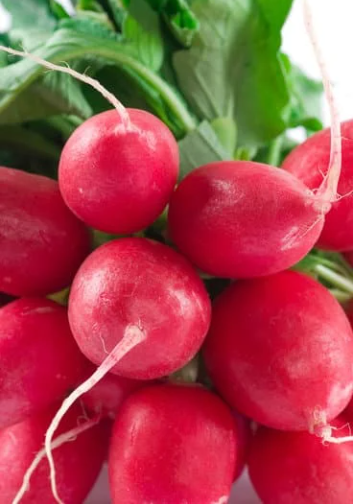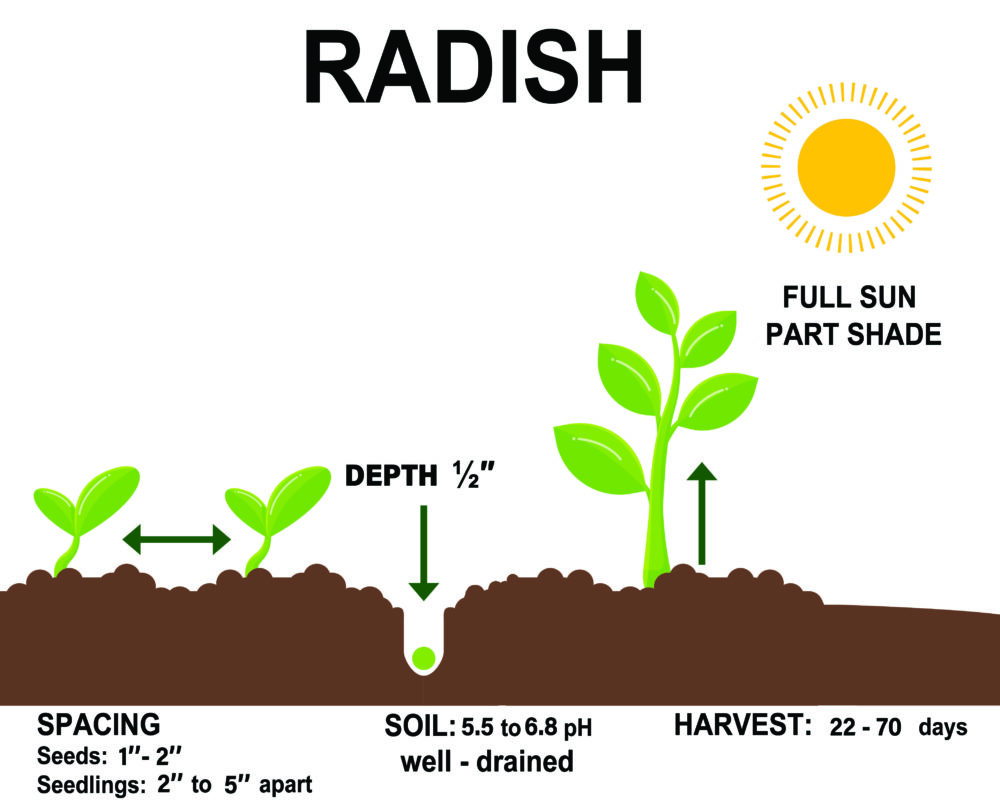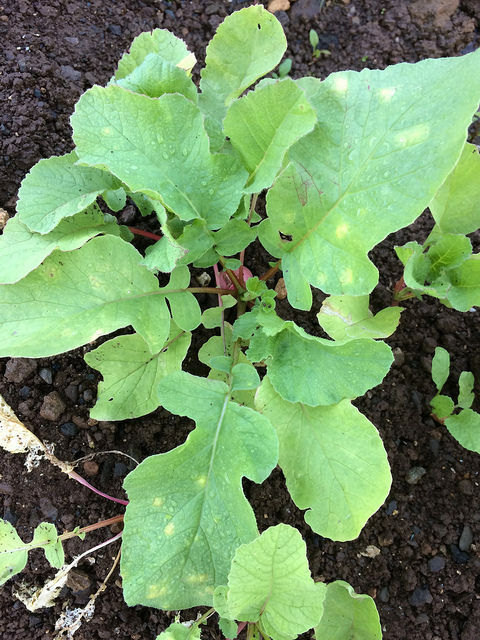When you think of a radish (Raphanus sativus), you most likely imagine the root vegetable that’s small, round, red, and tangy. The most popular radishes fit this description, though there are several varieties that differ in appearance. They can be round or oblong; hot or mild; red, pink, purple, white or bicolor.
Radishes are annual vegetables that are members of the Brassicaceae family, along with broccoli, cabbage, cauliflower, kale, and collards. They are planted in the spring (for a spring harvest) or late summer (for a fall harvest). And they have a quick growth rate. Some of the smaller varieties mature in as few as 30 days. The larger varieties can keep you waiting for up to 60 days.

| Common Name | Radish, common radish, garden radish, rabone |
| Botanical Name | Raphanus sativus |
| Family | Brassicaceae |
| Plant Type | Annual, vegetable |
| Size | 6 – 8 inches tall |
| Sun Exposure | Fun sun |
| Soil Type | Loamy, sandy, moist, well-drained |
| Soil pH | Acidic, neutral (6 to 7) |
| Bloom Time | Summer |
| Hardiness Zones | 2–11 (USDA) |
| Native Area | Asia |

When to Plant?
This will be determined by your planting zone. There is a final frost date for each area. As a result, you can plan your gardening activities around this date. Check our Frost Dates Across North America: First & Last Frost Dates Chart. However, the date will not be the same for every plant.
How to Plant
Start planting radishes in your garden 2 – 3 weeks before the average date of the last spring frost.
You can grow radishes in the open sun or partial shade.
Well-drained, loose soil works best for radishes.
From the beds on which you are going to plant radishes. It is necessary to remove stones, lumps of soil, roots, and other things that can interfere with proper root growth.
Before planting radishes, organic matter should be added to the beds.
Radish prefers a soil pH of 5.5 to 6.8.
Plant radish seeds ½ “deep and 1” apart.
The seedlings should be 2 to 5 inches apart.
Place individual rows or hills 10 to 15 inches apart.
Prepare beds with seasoned compost.
The radish beds should be moist, do not overflow. Prepare beds with seasoned compost.

How to Cultivate
Water – Keep the soil moist. As soon as first shoots appear, begin watering gently and regularly with a watering can. Radishes should never sit in water, but they do like sufficient moisture so that roots can grow plump.
Soil – 5.5 to 6.8 pH, well-drained
Spacing – seeds – 1″
Seedling – 2″ – 5″
Seed life: 4 years
Sun: Full sun/part shade
Germination: 3 – 4 days, 55°F – 85°F
Day to Harvest: 22 – 70 days
How to Harvest
It takes 22 to 70 days to harvest radishes. The radish is ready to harvest when the roots are 1 inch in diameter. To make sure your radishes are ready for harvest, gently lift the entire plant or move the soil around it.
Hydroponics
Germination: To start growing radishes hydroponically, you need to germinate the seeds. Soak the seeds in water for 12-24 hours and then place them in a moist paper towel. Keep the paper towel in a warm and dark place. After 2-3 days, you should see small sprouts appearing from the seeds.
pH range: Radishes prefer a pH range of 5.5-6.5. You can measure the pH level of your hydroponic solution using a pH meter or pH strips. If the pH level is too high, you can add a small amount of pH down solution to lower it. If it’s too low, you can add pH up solution to increase it.
EC: The EC (electrical conductivity) of your hydroponic solution should be between 1.2-2.2 mS/cm. This helps to ensure that the plants receive the right amount of nutrients
PPM: The PPM (parts per million) of your hydroponic solution should be between 700-1400 ppm. You can measure the PPM level using a TDS meter.
Humidity: Radishes require high humidity levels to grow properly. Keep the humidity level between 50-70% by using a humidifier or by spraying water in the air.
Light hours: Radishes need about 12-14 hours of light per day to grow properly. You can use grow lights or natural sunlight to provide light to your plants.
Temperature air: The ideal air temperature for radishes is between 60-70°F (15-21°C). Make sure to keep the temperature within this range to ensure optimal growth.
Temperature water: The water temperature for your hydroponic solution should be between 65-75°F (18-24°C). You can use a water heater or chiller to maintain the water temperature.
With these guidelines, you should be able to grow healthy plants hydroponically. Good luck, and happy growing!



